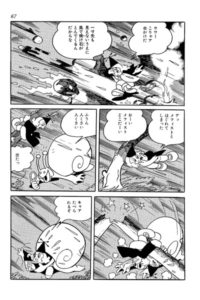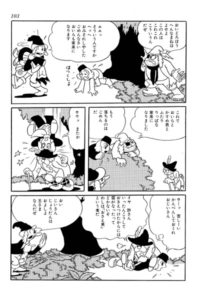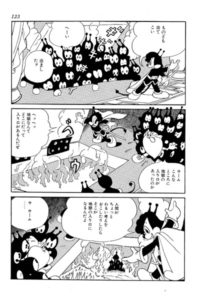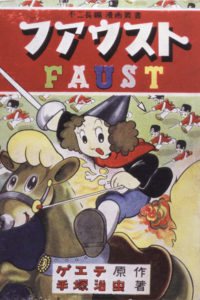Faust (Manga)
Also known as ファウスト (Fausuto)
| English Title: | Faust |
| In English? | No |
| Japanese Title: | ファウスト Fausuto |
| Type: | Book |
| Original run: | 1950/01/15 |
| Published by: | Fuji Shobo |
| Volumes: | 1 MT-060 |
Tezuka’s Faust (1950) was originally published as a stand-alone book by Fuji Shobo on Januauary 15, 1950. An adaptation of Goethe’s Faust, it is Tezuka’s first foray into re-imagining classic literature as manga.
What it’s about
When it’s brought to God‘s attention that Mephisto, a powerful, cunning and mischievous demon is causing all sorts of havoc in heaven – including casting angels down to Earth – God has the troublemaker brought before him and offers him a wager. With the fate of an eternal soul hanging in the balance, God bets that Mephisto will be unable to damn the human known as Heinrich Faust to Hell. Supremely confident in his abilities, Mephisto readily accepts the wager and immediately heads down to Earth to begin putting his plan into action.

Faust bemoans his lack of knowledge
Despite being a well-respected professor, Henrich Faust has reached a frustrating impasse in his studies and research. No matter how much he studies or what he does, it just does not seem possible to uncover all the secrets of the universe. Seeing his opportunity, Mephisto, in the guise of an anthropomorphic black dog, approaches Faust with an offer he can’t refuse – the satisfaction of all his earthly desires in exchange for his immortal soul. Blinded by the promise of youth, beauty and infinite knowledge, Faust goes along with Mephisto’s offer and the pair set off together to start fulfilling the terms.

A visit to the Harz Mountains on Walpurgis Night
After a visit to a witch’s lair returns Faust to his youthful appearance, he insists that Mephisto broker a meeting with the beautiful Princess Margarete. Although the pair fall for each other, things are never quite so simple. Once Margarete’s father, the king, learns of Faust’s magical abilities, he demands the near-impossible task of bringing back the goddess Helen – the most beautiful woman who ever lived.
Over the course of his quest to retrieve Helen, Faust first travels to the Harz Mountains, on the annual Walpurgis Night, and then to Pharsalian Fields – facing off against a variety of demons and monsters along the way. Although he’s successful, things go from bad to worse when Faust becomes implicated in the death of Margarete’s aggressive brother, Prince Valentine, and the king declares war on him! Of course, with the help of Mephisto, Faust recruits the Three Mighty Men to his cause and the king‘s forces are defeated.
As the dust settles Faust finally understands that what he has been searching for lies in the journey and not the destination – and inadvertently declares all his desires satisfied. That, of course, is music to Mephisto’s ears and he moves in to collect on their agreement. However, just in the nick of time, Margarete is revealed to be an angel sent to earth to protect Faust and she whisks him off to heaven, with the words “God grants salvation to those who strive with all their might” ringing in Mephisto’s ears.

The Three Mighty Men
What you should know
Faust (1950) is an adaptation of the tragic play Goethe’s Faust by Johann Wolfgang von Goethe, itself a reworking of an ancient German myth. Tezuka was a huge fan of Goethe’s Faust and regularly read it while in junior high school. So it should come as no surprise that he chose it as the source material for his first attempt to raise the (then quite low) status of manga by adapting classic literature – something he would attempt again and again in works such as Pinocchio (1952), Son-Goku the Monkey (1952-59), Cyrano, the Hero (1953), and, perhaps most famously, Crime and Punishment (1953).
Like many of his early works, Tezuka’s influence from the Takarazauka Revue shines through – notably during the scene near the beginning of the story featuring the Easter festival. However, even though Tezuka’s early Disney-esque art style is also clearly on display, readers may be interested to note that much of the visual design for Faust (1950) comes instead from the Soviet animated feature, The Little Humpbacked Horse (1947) – itself based on the poem by Pyotr Pavlovich Yershov.

Mephisto dragging Faust to Hell
As he wrote in the afterword to the Osamu Tezuka Complete Manga Works edition (MT-060), “the duo of the boy Ivan and the young horse in The Little Humpbacked Horse was the model for the relationship between Faust and the black dog in my version of Faust. The scene where Faust rides on the black dog flying through the sky was unmistakably inspired by The Little Humpbacked Horse” (1979, p. 169). In fact, he goes on to say that “The Little Humpbacked Horse had such a powerful influence on me. It was like a vicious punch. The style I used in Phoenix is also a rearrangement of The Little Humpbacked Horse.”
Tezuka was so absorbed by the tale of Faust that he returned to it again and again, throughout his career. Besides this example of his early work, Tezuka also re-adapted the tale mid-career as part of the Lion Books (1971-73) series of stories – that time giving it a much more domestic, rather than foreign, flavour for his readers by setting it during the Azuchi-Momoyama period of Japan. Finally at the very end of not only his career but also his life, he also re-adapted the tale as a then-contemporary story occurring in mid-20th century Tokyo. Unfortunately the blossoming classic Neo Faust (1988), was left forever incomplete by his untimely death.



